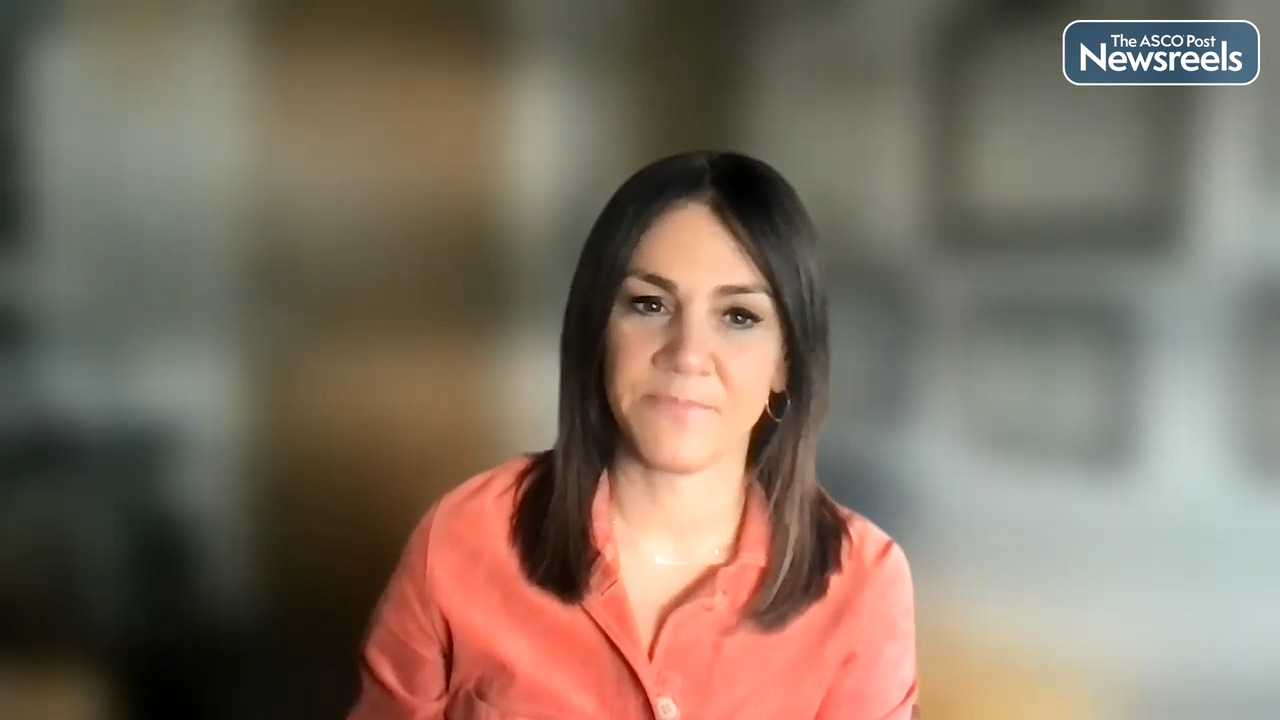Anita Mamtani, MD, on Axillary Dissection: For What Types of Breast Cancer Can It Be Avoided?
2023 Society of Surgical Oncology International Conference on Surgical Cancer Care
Anita Mamtani, MD, of Memorial Sloan Kettering Cancer Center, discusses study findings showing that axillary lymph node dissection was required by less than 2% of patients with cT1NO triple-negative or HER2-positive breast cancer having upfront surgery. There was no clear advantage of neoadjuvant chemotherapy in reducing the risk of lymph node dissection in this cohort. Upfront surgery is a suitable approach in these patients, says Dr. Mamtani, allowing for de-escalated chemotherapy regimens in patients with pathologic node-negative disease. (Abstract P1).
Transcript
Disclaimer: This video transcript has not been proofread or edited and may contain errors.
Our group at Memorial Sloan Kettering Cancer Center recently performed a study comparing rates of axillary dissection among clinical T1N0 triple-negative and HER2-positive breast cancer patients treated with neoadjuvant chemotherapy versus upfront surgery. This is a relevant question today in a time where the use of neoadjuvant chemotherapy among clinical T1N0 triple-negative and HER2-positive patients is controversial pitting the advantage of determining systemic therapy based on pathologic stage against the use of adjuvant therapy for those without a pathologic complete response. It is also unclear which approach results in a lower risk of axillary lymph node dissection, which of course is a procedure with significant risks of lymphedema and arm morbidity, and is a procedure that we aim to avoid whenever oncologically safe to do so.
In this study, we sought to examine the nodal disease burden and rates of axillary lymph node dissection in a population of clinical T1N0 triple-negative and HER2-positive cancers. We retrospectively evaluated a consecutive cohort of such patients treated from January 2020 through December 2021. As per the standard of care, axillary dissection was indicated for any positive sentinel nodes after neoadjuvant chemotherapy for the presence of three or more positive sentinel nodes in patients having upfront breast conserving surgery or mastectomy, or for patients with one to two positive sentinel nodes, having upfront mastectomy but not meeting criteria for post mastectomy radiation.
Clinical pathologic features, nodal disease bourbon, and the need for axillary dissection were then compared between patients who received neoadjuvant chemotherapy versus upfront surgery with the primary endpoint of interest being the rate of axillary dissection. 380 patients met our inclusion criteria of which 42% were triple-negative and 58% were HER2-positive, 8% received neoadjuvant chemotherapy followed by surgery. 67% had breast conserving surgery upfront and 25% had mastectomy upfront. Recipients of neoadjuvant chemotherapy more frequently had T1c tumors were younger and were more often triple-negative while other disease features were similar between the groups.
In the neoadjuvant chemotherapy group, we found that 93% of patients were pathologically node negative while 7% had residual nodal disease. In the upfront breast conserving surgery and mastectomy groups, the vast majority were similarly node-negative and less than 2% had three or more positive sentinel nodes. Overall, axillary lymph node dissection was required by 7% of patients after neoadjuvant chemotherapy versus 1.9% of patients who had upfront breast conserving surgery versus 2.1% of patients who had upfront mastectomy. On statistical analyses, no factors were significantly associated with axillary dissection including tumor stage, tumor subtype, or the neoadjuvant versus upfront surgery approach.
Finally, deescalation and systemic therapy was observed among many HER2-positive patients treated with upfront surgery. Among HER2-positive patients, 100% of those treated in the neoadjuvant setting received cytotoxic chemotherapy paired with dual agent HER2 therapy with trastuzumab and pertuzumab while 70% of patients treated with upfront surgery having been confirmed as pathologically stage I received Taxol and trastuzumab alone. On the other hand, chemotherapy regimens were similar among triple-negative patients in the neoadjuvant and adjuvant settings with the majority having received ACT.
In summary, we concluded from the study that axillary lymph node dissection was required by only 2% of clinical T1N0 triple-negative or HER2-positive patients having upfront surgery. There was no clear advantage of neoadjuvant chemotherapy in further reducing the risk of axillary dissection in this cohort and upfront surgery is therefore a suitable approach in these patients and may permit significant chemotherapy deescalation for pathologically node negative patients, particularly in the HER2-positive subset.
The ASCO Post Staff
Judy C. Boughey, MD, of the Mayo Clinic, discusses the decrease, over the past decade, of axillary lymph node dissection, especially in patients with node-positive breast cancer at diagnosis who had sentinel lymph node surgery after neoadjuvant chemotherapy. These findings are based on the records of more than 1,400 patients enrolled in the I-SPY2 trial. (Abstract 3).
The ASCO Post Staff
Kari M. Rosenkranz, MD, of Dartmouth Health, discusses findings from the ACOSOG Z11102 (Alliance) study, which showed that breast-conserving therapy is safe for patients with multiple ipsilateral breast cancer lesions, resulting in low recurrence rates. However, omitting adjuvant endocrine therapy is a risk factor for recurrence. (Abstract 1).


